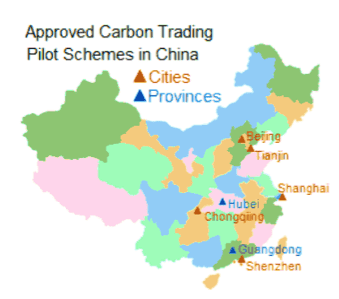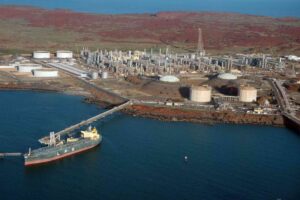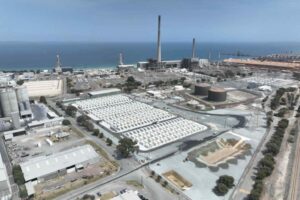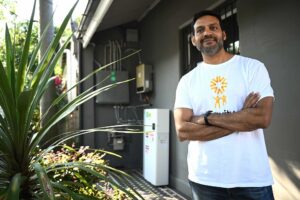The first of the seven planned Chinese pilot emission trading schemes, in Shenzhen, is to be launched today. While China has been indirectly pricing carbon for years, this scheme will be its first mandatory carbon market.
Second largest emissions trading scheme in the world
Pilot emission trading schemes are planned to start this year in Beijing, Chongqing, Guangdong, Hubei, Shanghai, Shenzhen and Tianjin.
These pilots are expected to cover around 700 million tonnes of CO2-e by 2014, which is a fraction of China’s total emissions, yet are still very significant. By comparison, Australia’s carbon price covers around 380 million tonnes, California’s 165 million tonnes and Europe’s 2.1 billion tonnes. (See Table 2 for comparison with Australia.) China plans to implement a national scheme around 2016 based on the lessons learned from the pilot schemes.
China is implementing a range of policies to address climate change, energy security and air pollution. If projections are accurate, these policies (see list of efforts on page 2) since 2005 will deliver a reduction in emissions of 4.5 billion tonnes of CO2 in 2020. This would be the largest single absolute reduction for any country in the history of action on climate change, and would equivalent of closing 1,000 500MW coal-fired power stations for a year.
Note also that China’s unabated appetite for coal is overstated. China has been the world’s largest investor in coal over the last decade but the nation’s energy use is undergoing significant change.
In 2011 coal plant investment was less than half of what it was in 2005. Inefficient coal generation have been progressive closed and last year coal consumption grew only 2.5 per cent compared to nearly 12 per cent in 2011.
Renewable energy accounted for over 19 per cent of generation in 2012 and combined with nuclear, accounted for over 90 per cent of all electricity generation growth last year.
Spotlight on Shenzhen
Shenzhen is one of the China’s Special Economic Zones, located next to Hong Kong. It is home to around 11 million permanent residents. The region is seeking too to build an advanced carbon finance centre. In 2011, its GDP was around $178 billion and per capita incomes were around $17,000.
Total emissions are estimated to be around 83 million tonnes in 2010 (compared to around 570 million in Australia).
Rules will differ between the pilot schemes to allow China to experiment with different emission trading scheme designs (see table 1). Shenzhen has committed to reduce the emissions intensity of its economy by 21 per cent below 2010 levels by 2015. Like the schemes in other major economics, Shenzhen’s market has an absolute emission limit.
This is around 32 million tonnes. This distinguishes it and other schemes from New Zealand’s emission market or the Coalition’s Emission Reduction Fund, which do not have a regulated cap on emissions.
The scheme will cover all companies with emissions over 20,000 tonnes of CO2-e and around 40 per cent of total emissions. It covers 26 sectors, including electricity and natural gas, water supply and industrial manufacturing.
Initially emission permits will be allocated to companies for free but this will be progressively reduced through time and income from the carbon price to be used to support the development of new carbon reduction technologies and projects.
Companies that pollute more than they are allowed will have to buy credits from those that reduce emissions below their targets. Companies will be charged three times the market price for each tonne of CO2 they emit over their cap if they fail to deliver enough credits. It is unclear at this point whether carbon prices for traded units will be public in the short-term.
Reasons for action
Chinese officials have cited numerous reasons for their climate action, including an effort to build energy security, reduce air pollution, foster new industries and contribute to global emission reductions. China’s significant investment in clean energy, for instance, has helped the emerging economy leapt ahead of countries like the United States in its ranking among the G20 nations in its ability to compete in a global low carbon economy. This year China ranked 3rd, up from 7th last year. If China had not increased its clean energy investments, it would be in 8th place.
Renewable energy in particular has had exponential growth. From having virtually no industry in 2005, China now has the largest installed capacity of wind power in the world and is the world’s largest producer of solar modules. China is now the world’s largest investor in renewable energy with around $65 billion invested in 2012. Between 2009 and 2011, China invested more money in renewable energy than it did in coal fired generation.
Is it enough?
Despite China’s recent efforts under current energy projections, emissions and coal use will keep growing until at least 2020. This is not inconsistent with a world seeking to avoid a 2°C increase in global temperature as long as an emissions peak by around this time.
Erwin Jackson is Deputy CEO of The Climate Institute










